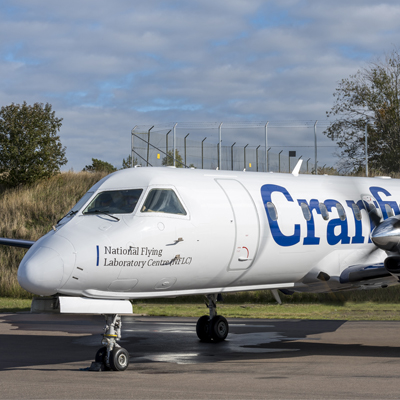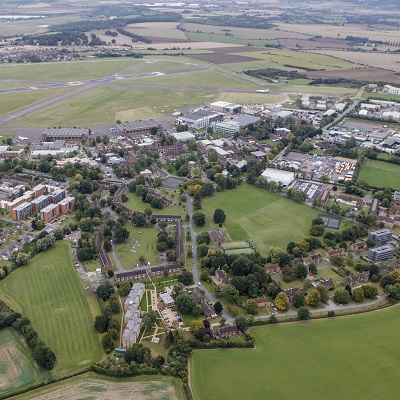The global market for drones and autonomous aerial vehicles is rapidly growing. With a rise in applications for unmanned aerial vehicles (UAV) and uncrewed aircraft systems (UAS), the defence and aerospace industries seek graduates conversant in key aspects of autonomy including: dynamics and control, guidance and navigation, decision making, sensor fusion, data and information fusion, communication and networking.
Students on the MSc in Autonomous Vehicle Dynamics and Control benefit from a distinct educational experience and unique facilities, including our drone laboratory, allowing you to gain hands-on experience in the development of the autonomous flight systems and technologies of tomorrow. The course content has been designed based on advice and industry insights from our Industrial Advisory Board, comprising industrial representatives from big primes to small- and medium-sized enterprises, and is accredited by the Royal Aeronautical Society (RAeS) on behalf of the Engineering Council as meeting the requirements for Further Learning for registration as a Chartered Engineer.Overview
- Start dateOctober
- DurationMSc: Full-time one year;
- DeliveryTaught modules 40%, individual research project 40%, group project 20%
- QualificationMSc
- Study typeFull-time
- CampusCranfield campus
Who is it for?
This course provides graduates from a range of disciplines with the advanced skills that can be applied to the security, defence, marine, environmental and aerospace industries. Typically, students have academic backgrounds in engineering, science, physics or applied mathematics and have a keen interest in aerospace and autonomous aerial vehicles.
Why this course?
This course is unique in that it offers a combination of subjects much sought after in the autonomous vehicle industry. Successful graduates of our MSc course become conversant in key aspects of autonomy which places them at an advantage in today's competitive employment market.
The Autonomous Vehicle Dynamics and Control MSc includes eight taught compulsory modules, which are generally delivered from October to March. The course begins with the fundamentals of autonomous vehicle dynamics and control, and progresses to the core subjects of guidance and navigation, sensor fusion, advanced control, decision making, AI for autonomous systems.
The taught segment of the course is followed by individual research projects (IRPs) and the topic of each of the IRPs is provided by one of the member of the Industrial Advisory Board. The real-world relevance of the IRP topics is another unique feature of the MSc course and can be another effective differentiator in the job market.
A key feature of the MSc is the inclusion of a CAA approved UAV remote pilot competence course. The course incorporates a ground school element for flight planning – covering principles of flight, rules and regulations of the air, using aviation charts, risk assessment and meteorology – and flight training to provide basic pilot competence, including how to respond in an emergency and being able to operate safety features. Successful completion of the course allows students to fly small UAV’s in the Open Category.
Discover the unique facilities available to you as a student on this course: My subject | Cranfield University Virtual Experience
Informed by industry
This course has been designed with industry in mind, and continues to be developed and kept up to date in collaboration with our Industrial Advisory Board. This includes:
| Boeing UK | Connected Places Catapult |
| Thales | Spirent |
| Ultra Electronics | BAE Systems |
| Barnard Microsystems | QinetiQ |
| FlyLogix Limited | Jaguar Land Rover UK |
| MBDA | General Atomics Aeronautical Systems UK |
| Blue Bear Systems Research Ltd. | Rolls-Royce |
| TTTech Computertechnik | Lockheed Martin UK |
| Northrop Grumman | BioCarbon Engineering |
| QuadSAT | HEROTECH8 |
| Computertechnik |
Members of the Board not only continuously advise on updating the course content but also provide topics for individual research projects (IRPs). After the final oral exams in early September, all students present posters summarising their IRPs to the whole Industrial Advisory Board, thus exhibiting their work to seasoned professionals and potential employers. The IRPs benefit from our own lab where real autonomous vehicles can be designed and tested.
Course details
The taught course element consists of lectures in three areas: dynamics, control systems, and autonomous systems and technology. The MSc course consists of two equally weighted components, taught modules and individual research project, and a group project.
Course delivery
Taught modules 40%, individual research project 40%, group project 20%
Group project
Individual project
Our industry partners sponsor individual research projects allowing you to choose a topic that is commercially relevant and current. Topics are chosen during the first teaching period in October and you begin work during the second half of the MSc course (May-August). The project allows you to delve deeper into an area of specific interest, taking the theory from the taught modules and joining it with practical experience.
Projects encompass various aspects of operations, not only concerned with design but including payloads, civil applications, system, sensors and other feasibility studies industry wishes to explore.
For the duration of the project, each student is assigned both a university and industry supervisor. In recent years, students have been based at sponsor companies for sections of their research and have been given access to company software/facilities.
During the thesis project all students give regular presentations to the course team and class, which provides an opportunity to improve your presentation skills and learn more about the broad range of industry-sponsored projects.
Previous projects have included:
Modules
Keeping our courses up-to-date and current requires constant innovation and change. The modules we offer reflect the needs of business and industry and the research interests of our staff and, as a result, may change or be withdrawn due to research developments, legislation changes or for a variety of other reasons. Changes may also be designed to improve the student learning experience or to respond to feedback from students, external examiners, accreditation bodies and industrial advisory panels.
To give you a taster, we have listed the compulsory and elective (where applicable) modules which are currently affiliated with this course. All modules are indicative only, and may be subject to change for your year of entry.
Course modules
Compulsory modules
All the modules in the following list need to be taken as part of this course.
UAS Dynamics and Control
| Aim |
|
|---|---|
| Syllabus |
|
| Intended learning outcomes |
On successful completion of this module a student should be able to:
|
Aerial Communications Systems
| Module Leader |
|
|---|---|
| Aim |
|
| Syllabus |
Overview of airborne communications:
Aeronautical Communication:
Communications system design:
Antennas design:
Communications Networking:
Case study:
|
| Intended learning outcomes |
On successful completion of this module you should be able to:
|
UAS Modelling and Simulation
| Aim |
Mathematical modelling and simulation of unmanned aerial vehicles is a vital part of system development. Nowadays COTS components becoming more powerful and can multi-task and carry-out complex computations.You would need to learn the technical skills not only for the modelling and simulation but also the real-time implementation of the algorithms. The aims of this course is to provide you with the skills and knowledge necessary to model, simulate and then critically analyse the resultant non-linear motion of unmanned air vehicles using mainly Matlab/Simulink and target compile the algorithms on an embedded flight control system.
|
|---|---|
| Syllabus |
• Model building; model testing, validation and management; trimming and numerical linearisation (10 hours). • Control implementation and testing on COTS FCS |
| Intended learning outcomes |
On successful completion of this module a student should be able to: 1. Design and implement an example UAV model in terms of their aerodynamic, control, mass and inertia characteristics. Appraise and critically compare the resultant motion. |
Sensor Fusion
| Aim |
The aim of this module is to provide an overview of sensor fusion architectures, algorithms and applications in the context of autonomous vehicles navigation, guidance and control both for linear and non-linear systems. The module aims also to give you an understanding of the appropriate tools for error analysis, diagnostic statistics and heuristics enabling them to critically evaluate the performance of a sensor fusion architecture/algorithm. The main emphasis is on the Kalman Filter algorithm together with variants and generalisations, applied to target tracking problems. |
|---|---|
| Syllabus |
• Statistical Analysis
• Linear Kalman Filter and Linear Kalman Smoother • Inertial navigation • Constrained filters • Sensor Integration architectures and Multiple sensor fusion • Non-linear filters (EKF, UKF and Particle Filters) • Case Study: Inertial navigation • Case Study: Multiple sensor fusion |
| Intended learning outcomes |
On successful completion of this module you should be able to: 1. Understand the fundamental principles in stochastic processes and in estimation theory. |
Autonomous Vehicle Control Systems
| Aim |
This module aims to provide you with fundamental understanding and knowledge of the advanced control systems and their applications to autonomous vehicles. Building upon the foundational “UAS Dynamics and Control” module, advanced control methods are presented and analysed to mitigate limitations of the conventional linear control approaches. A key aim is for you to critically understand the properties of the system model, the fundamental working principals of the advanced control approaches together with their advantages and limitations. |
|---|---|
| Syllabus |
Overview of autonomous vehicles performance requirement;
System identification and modelling; Uncertainty representation; Pole placement and gain scheduling; Robust H-infinity control; Adaptive and non-linear control system design and its application to autonomous vehicles; |
| Intended learning outcomes |
On successful completion of this module you should be able to: 1. Appraise the nature, purpose, design procedure of advanced control systems for autonomous vehicles; |
Artificial Intelligence for Autonomous Systems
| Module Leader |
|
|---|---|
| Aim |
|
| Syllabus |
|
| Intended learning outcomes |
On successful completion of this module you should be able to:
|
Guidance and Navigation for Autonomous Systems
| Aim |
|
|---|---|
| Syllabus |
• Introduction on navigation and guidance systems;
• Path planning for autonomous systems • Path following for autonomous systems • UAV (Unmanned Aerial Vehicle) guidance systems; • Guidance approaches: conventional guidance such as PN (Proportional Navigation), geometric guidance, and optimal guidance; • Navigation approaches: navigation systems, GNSS (Global Navigation Satellite System), terrain based navigation, SLAM (Simultaneous Localisation and Mapping); • Cooperative guidance and collision avoidance. |
| Intended learning outcomes |
On successful completion of this module you should be able to:
|
Logic and Automated Reasoning
| Aim |
It also introduces Causal Logic linking it to the founding principles of Machine Learning. |
|---|---|
| Syllabus |
Introduction to logic representation and reasoning |
| Intended learning outcomes |
On successful completion of this module you should be able to:
|
Teaching team
You will be taught by Cranfield's experienced academic staff. Our staff are practitioners as well as tutors, with clients which include the members of the Industrial Advisory Board and beyond. Knowledge gained working with our clients is continually fed back into the teaching programme, to ensure provision of durable and transferrable skills practised on problems relevant to industry. Additionally, experienced members of the Industrial Advisory Board deliveriIndustrial seminars in which they share their experience and explain the research and development proprieties of their companies. The Course Director for this programme is Dr Argyrios Zolotas.
This MSc course was interesting and coherent, and the cutting edge technology tailored towards aeronautical industry’s upcoming developments. I had the opportunity to experience new challenges and work on impressively ambitious projects which were highly rewarding. It provided me with the skills and knowledge I needed to start my career, and I found the job I wanted immediately after completing the MSc. Moreover, with brilliant staff and outstanding facilities, Cranfield is a wonderful place to study.
Autonomous Vehicle Dynamics and Control is a very unique course. It has a lot of interesting areas. In particular, the cutting edge technology. This course will definitely help me in my future career. Cranfield is a very good learning environment.
The overall experience has been really positive, and has provided me with the needed tools to find a job that I love and where I can put forth all the knowledge that I gained during the MSc.
I chose to study at Cranfield University due to its great reputation and the impact that students and staff play in the world. A highlight from my time at Cranfield has been being able to work with dedicated and very professional members of staff and academics. My Individual Thesis Project focused on Flight Controller Actuator Controller Development and was sponsored by Domin Fluid Power. After I finish my MSc my will be working full time in France at Safran Aircraft Engines.
I chose to study at Cranfield University as it is highly specialised in my field. A highlight from my time would have to be the Group Project, my project focused on a UAV swarm for search and rescue missions. For my Individual Research Project, I worked on a Multi-UAV Surveillance which was sponsored by Barnard Microsystems.
Accreditation
The Autonomous Vehicle Dynamics and Control MSc is accredited by the Royal Aeronautical Society (RAeS) on behalf of the Engineering Council as meeting the requirements for further learning for registration as a Chartered Engineer (CEng). Candidates must hold a CEng accredited BEng/BSc (Hons) undergraduate first degree to show that they have satisfied the educational base for CEng registration.
Your career
The industry-led education makes Cranfield graduates some of the most desirable all over the world for recruitment by companies competing in the autonomous vehicle market including:
- BAE Systems,
- Defence Science and Technology Laboratory,
- MBDA,
- Other companies from our Industrial Advisory Board.
Graduates from this course will be equipped with the advanced skills which could be applied to the security, defence, marine, environmental and aerospace industries. This approach offers you a wide range of career choices as an autonomous systems engineer, design engineer or in an operations role, at graduation and in the future. Others decide to continue their education through PhD studies available within Cranfield University or elsewhere.
Cranfield’s Career Service is dedicated to helping you meet your career aspirations. You will have access to career coaching and advice, CV development, interview practice, access to hundreds of available jobs via our Symplicity platform and opportunities to meet recruiting employers at our careers fairs. Our strong reputation and links with potential employers provide you with outstanding opportunities to secure interesting jobs and develop successful careers. Support continues after graduation and as a Cranfield alumnus, you have free life-long access to a range of career resources to help you continue your education and enhance your career.
How to apply
Click on the ‘Apply now’ button below to start your online application.
See our Application guide for information on our application process and entry requirements.



















